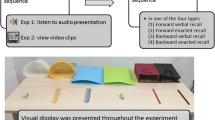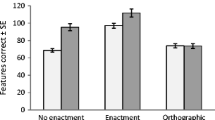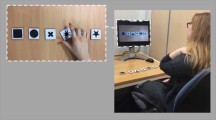Abstract
Recent studies examining working memory for sequences of instructions have demonstrated a performance advantage when the instructions are physically enacted rather than verbally recalled. However, little is known about the source of this effect, or how instructions are stored in working memory more generally. In particular, no previous studies have compared the impacts of enactment on encoding versus recall in working memory. We conducted an experiment to examine the impacts of enactment on both the encoding and recall phases of a task measuring memory for sequences of simple action–object pairs (e.g., touch the circle, spin the cross, flip the square, . . .) in young adult participants. An advantage for enacted over verbal recall was observed, in line with recent evidence. In addition, the enactment of actions during the encoding phase on each trial significantly facilitated subsequent performance; this effect was particularly apparent for verbal repetition rather than enacted recall. These findings are interpreted as reflecting a beneficial role for spatial–motoric coding in working memory that can be engaged through either action planning or physical performance.


Similar content being viewed by others
Notes
The mean proportions of pairs correctly recalled in any serial position (i.e., item memory, regardless of order) were also analyzed, and they produced the same outcomes as the serial-recall measure.
References
Bäckman, L., & Nilsson, L. G. (1984). Aging effects in free recall: An exception to the rule. Human Learning: Journal of Practical Research and Applications, 3, 51–69.
Baddeley, A. D. (1986). Working memory. Oxford, UK: Oxford University Press, Clarendon Press.
Baddeley, A. D. (2000). The episodic buffer: A new component of working memory? Trends in Cognitive Sciences, 4, 417–423. doi:10.1016/S1364-6613(00)01538-2
Baddeley, A. D. (2003). Working memory: Looking back and looking forward. Nature Reviews Neuroscience, 4, 829–839. doi:10.1038/nrn1201
Baddeley, A. D. (2012). Working memory: Theories, models, and controversies. Annual Review of Psychology, 63, 1–29. doi:10.1146/annurev-psych-120710-100422
Baddeley, A. D., Allen, R. J., & Hitch, G. J. (2011). Binding in visual working memory: The role of the episodic buffer. Neuropsychologia, 49, 1393–1400. doi:10.1016/j.neuropsychologia.2010.12.042
Baddeley, A. D., Hitch, G. J., & Allen, R. J. (2009). Working memory and binding in sentence recall. Journal of Memory and Language, 61, 438–456.
Baddeley, A. D., & Lieberman, K. (1980). Spatial working memory. In R. S. Nickerson (Ed.), Attention and performance VIII (pp. 521–539). Hillsdale, NJ: Erlbaum.
Baddeley, A. D., & Logie, R. H. (1999). Working memory: The multiple-component model. In A. Miyake & P. Shah (Eds.), Models of working memory: Mechanisms of active maintenance and executive control (pp. 28–61). Cambridge, UK: Cambridge University Press.
Bo, J., & Seidler, R. D. (2009). Visuospatial working memory capacity predicts the organization of acquired explicit motor sequences. Journal of Neurophysiology, 191, 3116–3125.
Charlesworth, L. A., Allen, R. J., Morson, S., Burn, W. K., & Souchay, C. (2014). Working memory and the enactment effect in early Alzheimer’s disease. ISRN Neurology, 2014, 694761. doi:10.1155/2014/694761
Cohen, R. L. (1981). On the generality of some memory laws. Scandinavian Journal of Psychology, 22, 267–282.
Cohen, R. L. (1989). Memory for action events: The power of enactment. Educational Psychology Review, 1, 57–80.
Delogu, F., Raffone, A., & Belardinelli, M. O. (2009). Semantic encoding in working memory: Is there a (multi)modality effect? Memory, 17, 655–663. doi:10.1080/09658210902998054
Engelkamp, J. (1998). Memory for actions. Hove, UK: Psychology Press.
Engelkamp, J., & Zimmer, H. D. (1989). Memory for action events: A new field of research. Psychological Research, 51, 153–157.
Engelkamp, J., & Zimmer, H. D. (1995). Similarity of movement in recognition of self-performed tasks and of verbal tasks. British Journal of Psychology, 86, 241–252.
Freeman, J. E., & Ellis, J. A. (2003). The representation of delayed intentions: A prospective subject-performed task? Journal of Experimental Psychology: Learning, Memory, and Cognition, 29, 976–992. doi:10.1037/0278-7393.29.5.976
Frith, C. D., Blakemore, S. J., & Wolpert, D. M. (2000). Abnormalities in the awareness and control of action. Philosophical Transactions of the Royal Society B, 355, 1771–1788.
Gathercole, S. E., Durling, E., Evans, M., Jeffcock, S., & Stone, S. (2008). Working memory abilities and children’s performance in laboratory analogues of classroom activities. Applied Cognitive Psychology, 22, 1019–1037.
Koriat, A., Ben-Zur, H., & Nussbaum, A. (1990). Encoding information for future action: Memory for to-be-performed tasks versus memory for to-be-recalled tasks. Memory & Cognition, 18, 568–578. doi:10.3758/BF03197099
Logie, R. H. (1995). Visuo-spatial working memory. Hove, UK: Erlbaum.
Logie, R. H., Engelkamp, J., Dehn, D., & Rudkin, S. (2001). Actions, mental actions, and working memory. In M. Denis, R. H. Logie, C. Cornoldi, J. Engelkamp, & M. De Vega (Eds.), Imagery, language and visuospatial thinking (pp. 161–184). Hove, UK: Psychology Press.
Quinn, J. G. (1994). Towards a clarification of spatial processing. Quarterly Journal of Experimental Psychology, 47A, 465–480.
Quinn, J. G., & Ralston, G. E. (1986). Movement and attention in visual working memory. Quarterly Journal of Experimental Psychology, 38A, 689–703.
Saltz, E., & Donnenwerth-Nolan, S. (1981). Does motoric imagery facilitate memory for sentences? A selective interference test. Journal of Verbal Learning and Verbal Behavior, 20, 322–332.
Smyth, M. M., Pearson, N. A., & Pendleton, L. R. (1988). Movement and working memory: Patterns and positions in space. Quarterly Journal of Experimental Psychology, 40A, 497–514.
Smyth, M. M., & Pendleton, L. R. (1989). Working memory for movements. Quarterly Journal of Experimental Psychology, 41A, 235–250.
Sternberg, S., Monsell, S., Knoll, R. L., & Wright, C. E. (1978). The latency and duration of rapid movement sequences: Comparisons of speech and typewriting. In G. E. Stelmach (Ed.), Information processing in motor control and learning (pp. 117–152). New York, NY: Academic Press.
Wojcik, D. Z., Allen, R. J., Brown, C., & Souchay, C. (2011). Memory for actions in autism spectrum disorder. Memory, 19, 549–558.
Yang, T., Gathercole, S. E., & Allen, R. J. (2014). Benefit of enactment over oral repetition of verbal instruction does not require additional working memory during encoding. Psychonomic Bulletin & Review, 21, 186–192. doi:10.3758/s13423-013-0471-7
Zimmer, H. D. (2001). Why do actions speak louder than words: Action memory as a variant of encoding manipulations or the result of a specific memory system? In H. D. Zimmer, R. Cohen, M. Guynn, J. Engelkamp, R. Kormi-Nouri, & M. Foley (Eds.), Memory for action: A distinct form of episodic memory? (pp. 151–198). New York, NY: Oxford University Press.
Zimmer, H. D., Helstrup, T., & Engelkamp, J. (2000). Pop-out into memory: A retrieval mechanism that is enhanced with the recall of subject-performed tasks. Journal of Experimental Psychology: Learning, Memory, and Cognition, 26, 658–670.
Author information
Authors and Affiliations
Corresponding author
Rights and permissions
About this article
Cite this article
Allen, R.J., Waterman, A.H. How does enactment affect the ability to follow instructions in working memory?. Mem Cogn 43, 555–561 (2015). https://doi.org/10.3758/s13421-014-0481-3
Published:
Issue Date:
DOI: https://doi.org/10.3758/s13421-014-0481-3




